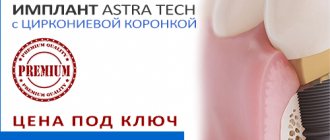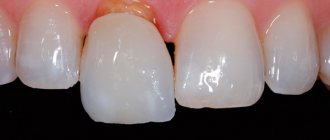Tooth enamel and dentin are among the hardest tissues in the human body. They cope well with mechanical loads, withstand exposure to organic acids and resist bacteria. To keep your teeth strong, you need to follow simple rules:
- regularly remove plaque and rinse your mouth after eating,
- avoid eating very solid foods,
- do not wash down hot meals with cold drinks,
- Do not crack nuts, bite threads or open bottles with your teeth.
If you neglect the recommendations of dentists, the enamel will become thinner and lose its protective properties. This increases the risk of cracks and other defects. We will tell you what causes damage, what symptoms should you see a doctor for, and whether it is possible to restore a molar that has split into two parts.
Causes of a crack in the root of a tooth
Not all patients understand why a root crack occurs in a living tooth. The reason lies in the uneven distribution of the load. Moreover, the load can be strong and sudden, or it can accumulate over years and lead to the appearance of a crack after some time.
Typically, the cause of a crack is caused by the following factors:
- domestic trauma
- blow, fall, sudden load while chewing; - improper treatment
- strong pressure when cleaning canals or filling the root can injure the walls and in the future, with the slightest excessive load, cause a crack in the root; - error during prosthetics
- strong pressure when installing a pin or the manufacture of inappropriate dentures that unevenly distribute the load during chewing, leading to injury; - Bruxism
- unconscious clenching of the jaws, for example, during sleep, leads to a load that the patient does not notice and cannot control.
What Causes Injury?
The main reason why tooth crown damage occurs is weakened enamel.
In such cases, microcracks and chips often form, which subsequently lead to a crown fracture. But even strong teeth can be injured under strong mechanical stress, however, this usually happens simultaneously. The reason for the weakening of the enamel can be:
- poor quality dental treatment;
- deficiency of calcium, phosphorus and fluorine;
- violation of nutrition rules;
- constant exposure to food acids;
- disruption of the pancreas with uneven release of acidity;
- the effect of different temperatures when eating food (hot-cold);
- jaw injuries.
With weakened teeth, a crack can also occur as a result of the habit of chewing hard objects or foods, nails, packaging, etc.
Dentists warn that those at greatest risk are patients who have had prior dental treatment with pulp removal or a filling placed on a large, diseased crown cavity.
Types of tooth root crack
Pressure can be applied both vertically and perpendicularly to the crown. The following types of cracks are distinguished:
- oblique crack of a tooth
- a diagonal fracture, usually the healthy part is much larger, and the doctor can save the tooth by removing the affected part; - transverse crack of a tooth
- part of the root is completely broken off and deprived of nutrition; the closer the crack is to the coronal part, the higher the risk of complications; - longitudinal crack in the root of a tooth
- the fracture runs vertically, along the axis of the root, often accompanied by a fracture of the crown; - comminuted tooth crack
- multiple root fractures intersecting with each other.
Symptoms
The most common symptoms are:
- pain that does not have an exact location (radiates to different parts of the dentition);
- increased sensitivity of the enamel (this is strongly felt when eating hot or cold foods);
- severe discomfort while chewing food.
If vertical damage leads to pulpitis, then the patient develops a characteristic putrid odor from the oral cavity, which cannot be gotten rid of even after cleaning.
As tissue necrosis develops, the color of the enamel may change, the gums may swell, and become very painful when pressed. Very often the damage affects the root, and this leads to severe loosening of the tooth.
Let's talk about what you can do when your front teeth are loose - how to strengthen them at home and in dentistry.
Root crack diagnosis
Only a doctor can diagnose an injury. First, the specialist makes a preliminary diagnosis based on the patient’s symptoms and complaints. More detailed research is required to clarify.
- Instrumental examination.
By tapping the tooth, the doctor determines whether there are irregularities, fractures or bleeding in the root of the tooth. - X-ray.
The image clearly shows the tooth root crack, its location and the severity of the injury. - Electrical exposure
helps determine the condition of the pulp.
Diagnosis and treatment
During the diagnosis, the specialist:
- evaluates patient complaints,
- examines the oral cavity,
- performs testing with coloring reagents,
- examines the x-ray.
After assessing the size of the crack and the depth of tissue damage, the dentist draws up a treatment plan. It may include:
- remineralization and fluoridation of enamel,
- tooth restoration,
- installation of a crown on a pin,
- removal of a damaged tooth followed by implantation.
The choice of treatment method depends on the nature of the tooth damage, the condition of the root, and existing contraindications. Dentists try to preserve their patients' teeth.
Crack in the root of a tooth: what to do
After diagnosis, patients are concerned with the question of whether it is possible to cure a crack in the root of a tooth. It all depends on the severity of the injury, the type of fracture and location. But there is no therapeutic treatment - tablets, ointments and injections; in any case, surgical intervention is necessary.
Ⅰ.
In case of a transverse fracture, the tooth can be saved, but the pulp is removed without exception. The doctor cleans and fills the root canals, and fastens the crack with a pin. Now the tooth needs rest and a minimum of chewing load - to reduce mobility, the teeth are splinted, that is, fixed in the correct position with a special splint-onlay.
Ⅱ.
Splintered, vertical and oblique cracks in most cases are only the initial stage of destruction of the root system, and over time the fault will grow. Therefore, depending on the severity of the injury, the doctor removes either part of the root with a crown or the entire tooth. A partially lost tooth can be restored using an inlay on a pin, or a complete tooth can be restored by installing a prosthesis or implant.
Treatment of a crack in the root of a tooth requires following the following recommendations:
- limit the chewing load - it is better to eat soups, cereals and other soft foods, avoid hard foods;
- monitor the temperature - all foods and drinks should be slightly warm, ice cream or hot tea have an undesirable effect on the injured root;
- eliminate pressure - do not open your mouth wide, do not close your jaw too tightly, brush your teeth carefully, avoid blows.
Is it possible to save a cracked tooth?
It all depends on the scale of the damage: the depth and length of the crack, its location. Solving the problem on your own with the help of folk remedies and toothpaste will not give an effect, and delaying professional treatment will only worsen the situation.
Important! Cracked teeth do not heal.
To assess the possibility of restoring a cracked tooth and choose the optimal treatment method, each specific case should be considered separately.
Only the tooth enamel is cracked
Enamel cracks are minimal damage to the integrity of the tooth, almost invisible to the naked eye. The dentist will carefully polish the crown, gradually removing microscopic layers, and remineralize it with fluoride-containing gel. However, treatment should not be delayed. Consequences of cracks in tooth enamel: caries, increased damage in depth and, as a result, inflammation of the nerve.
Important! Before treating a cracked tooth, Matisse Dent dentists perform an antiseptic treatment of the oral cavity. The procedure destroys pathogenic bacteria. The success of treatment and the service life of the restored tooth depend on this.
Complications and consequences of a root crack
In this situation, timely treatment is important: seeing a doctor at the initial stage will help avoid consequences. If this is not done, you may encounter the following complications:
- abscess.
A crack without treatment can provoke an inflammatory process, which in the future will turn into suppuration of soft tissues and lead to the formation of an abscess. Treatment of a purulent cavity is much longer, more expensive and unpleasant than treatment of a fissure; - phlegmon.
Suppuration, which, unlike an abscess, does not have clear boundaries and does not flow into the formation of a cavity. Cellulitis is a decay of cells that can spread to any tissue in the cavity; - periodontitis.
Inflammation of the periodontium, that is, the tissues surrounding the tooth, leads to their death and the inability to hold the tooth in the gum. The result is the complete loss of one or more teeth; pulpitis. The death of the pulp - the neurovascular bundle of tissues in the tooth through which it receives nutrition. Pulpitis is quite painful and can affect neighboring tissues; - tissue injury.
A root fragment can injure soft tissue. In this case, the doctor will have to extract a piece of the root and remove the infected tissue.
Causes of dental chips
There are many circumstances that can lead to partial tooth destruction; among the most common, experts note the following:
- Injuries received by mechanical means, from which people who lead an active lifestyle or choose extreme sports are least insured (children jumping like saigas and teenagers fighting behind garages also fall into this category). Although, by and large, this reason is quite common, tooth damage can be caused by blows, falls, accidents, which, unfortunately, happen every day.
- Demineralization of tooth enamel, lack of calcium, fluoride and other microelements necessary to strengthen teeth are typical for women during pregnancy and lactation, and the elderly.
- Weakening of enamel due to overuse of sweet or sour foods, viscous and hard foods, exposure to high and low temperatures is at risk for those with a sweet tooth, especially those who like to drink ice cream with hot coffee.
- Carious lesions of the enamel of dental tissue, which can penetrate to the very root and significantly reduce the strength of the tooth, making it fragile and unstable even to small loads.
- An incorrect bite that disrupts the balance of stress on the dentition, which can lead to the abrasion of enamel and the appearance of areas with exposed dentin.
- Disturbed hormonal metabolism, weakened immunity, poor heredity.
- Bad habits, such as heavy smoking, the habit of cracking nuts with your teeth or opening beer bottles with your teeth like a hussar.
- Poor installation of the seal or its destruction.
Child's tooth chipped
Prevention of root injuries
The best treatment is disease prevention. To prevent cracks at the root, try to follow a few recommendations:
- be careful and attentive, because half of the cases of root cracks are household injuries, which can be avoided if you take care of yourself and your health;
- carefully choose a clinic and a doctor - before visiting a dentist, check the reviews and ratings of the clinic, certificates and specialist diplomas, do not go to questionable dentists;
- strengthen your teeth - eat healthy foods, do not forget about the importance of calcium and fluoride in strengthening your teeth, choose suitable dental hygiene products.
If symptoms of a root crack occur, do not self-medicate and do not wait for the pain to go away on its own. See your doctor. If the pain is caused by a temporary phenomenon, you will be calm, and if a crack is discovered at the root, treatment at the initial stage will help maintain the health and beauty of your smile, avoid complications and unnecessary expenses.
Dentists' recommendations
If a tooth is cracked, you can save it, but you should make an appointment with your dentist right away. The sooner professional help is provided, the less likely there are complications.
Before visiting a doctor, you should adhere to the following recommendations:
- the load on the injured tooth is completely eliminated;
- take only soft or ground food of medium temperature;
- Every hour, rinse your mouth with antiseptic agents, saline solutions or herbal decoctions.
Experts strongly advise against touching a damaged tooth with your fingers or tongue. You should not loosen it or try to use any popular recommendations. When a tooth is cracked, it can only be saved by going to the dentist.
Chips are different
Dental chips are deep injuries that expose the nerve. Such injuries usually cause severe pain and increased sensitivity. It even happens that the tooth bleeds. In this case, it is necessary to treat the root canal and, most likely, remove the nerve. Next, the tooth is filled (if possible) or a crown is placed.
Deep vertical cracks originate at the base of the tooth and rise up to the chewing surface, causing acute pain. It is likely that the area around the root will become inflamed if it becomes infected. Such a tooth will most likely need to be removed, but the final decision is made by the dentist after an examination.
If the tooth has deteriorated due to internal voids, then you will need to take an X-ray to assess the scale of the “catastrophe.”
Typically, specialists determine the size and nature of the cavity, and then make recommendations for restoring the tooth. It happens that a tooth has to be removed because the void continues to grow towards the bone. Moscow metro station Zvezdnaya, Danube Avenue, 23
Restoration method – bridge prosthesis
Dental bridges got their name for their visual resemblance to a bridge - they are a structure of two crowns, between which artificial teeth are located.
Crowns are placed on your own ground teeth. The advantages of bridges are good aesthetics and reliable fixation. Dental bridges are permanent, making them very comfortable. This type of dental prosthetics requires several visits to the doctor. First, impressions are made, from which a temporary prosthesis is made in a denture laboratory or clinic - the patient will not experience discomfort when communicating due to the absence of a front tooth. At the same time, the dental clinic prepares the supporting teeth. They are ground to install a crown to a shape that is optimally suitable for this, and most often (but not always) they are depulped. After the grinding is completed, impressions are taken again, from which dentists make a permanent prosthesis, and after that it is installed on the supporting teeth and fixed with cement.
The main disadvantage of a bridge is the need for depulpation and grinding of healthy supporting teeth. In addition, its installation, which leads to an uneven load on the alveolar bone and its thinning in the area of the missing tooth..











